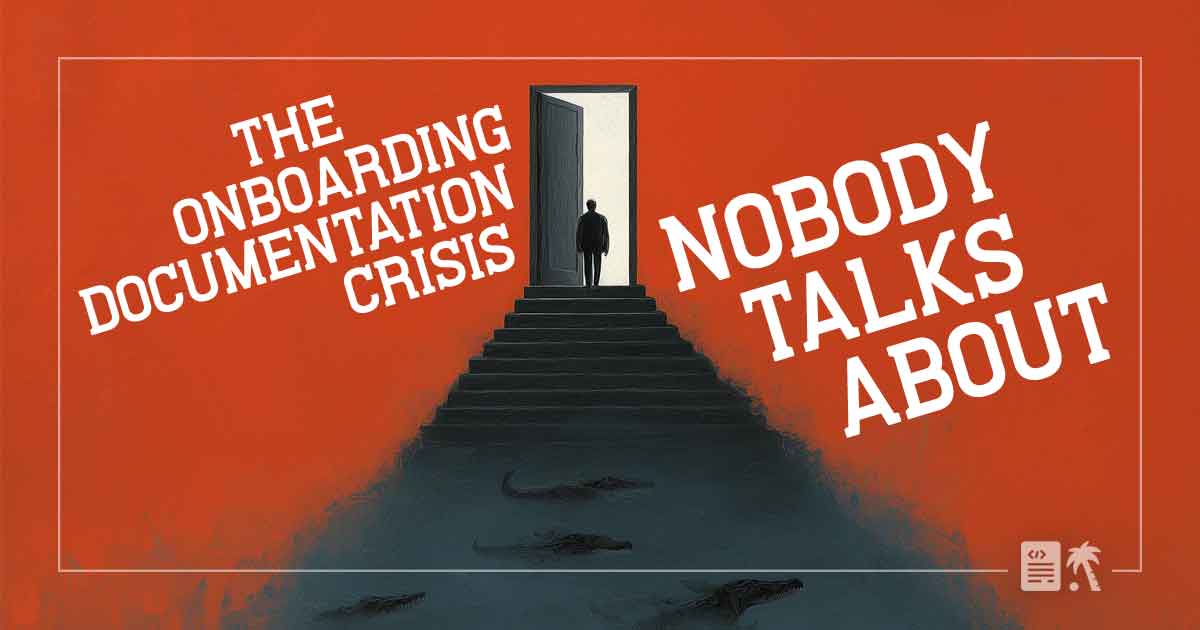How Great Documentation Attracts Better Developers


In today's challenging job market, companies that do have engineering roles to fill face a different kind of competition. With fewer positions available and more developers looking for opportunities, the focus has shifted from just attracting talent to attracting the right talent—developers who will make a meaningful impact and stay for the long term. While most companies compete on salary and benefits, the smartest organizations have discovered a secret weapon hiding in plain sight: exceptional documentation.
Great documentation doesn't just make your product easier to use—it makes your company irresistible to the kind of developers you actually want to hire. The developers who care about code quality, who think strategically about architecture, who want to build something meaningful rather than just collect a paycheck. These developers can smell a well-organized codebase from a mile away, and they're drawn to companies that demonstrate they care about craft, clarity, and long-term thinking.
Think about it from a developer's perspective. When they're evaluating your company, they're not just looking at your job posting or your glassdoor reviews. They're looking at your GitHub repositories, your technical blog posts, your API documentation, and your internal wikis. Every piece of technical content you create is essentially a portfolio piece that shows whether your engineering culture values excellence or just ships features and hopes for the best.
The Developer Experience Signal
Research from Stack Overflow reveals that 53% of developers want their employer to prioritize developer experience at work. But what creates great developer experience? It's not just fast computers and multiple monitors—it's the entire ecosystem that enables developers to be productive, confident, and successful.
Documentation sits at the heart of developer experience. When developers can quickly understand your architecture, find the information they need, and confidently make changes without breaking things, they feel empowered rather than frustrated. When your onboarding documentation gets new hires productive in days rather than weeks, they feel welcomed rather than abandoned. When your troubleshooting guides actually help solve problems, developers feel supported rather than stressed.
The same Stack Overflow research found that 35% of developers find a structured onboarding process appealing, and 33% are attracted to companies that make it easy to find experts within the organization. Both of these benefits flow directly from great documentation. Structured onboarding requires clear, comprehensive guides that walk new hires through your systems, processes, and culture. Making it easy to find experts requires documentation that identifies who knows what and how to reach them.
On the flip side, 54% of developers find companies unattractive when they don't have the resources to feel confident in their work. Poor documentation is one of the fastest ways to undermine developer confidence. When developers can't understand how systems work, can't find examples of how to implement features, or can't troubleshoot problems effectively, they feel incompetent even when they're highly skilled.
The Performance Multiplier Effect
DORA research has found a clear link between documentation quality and organizational performance, but the numbers are more dramatic than most people realize. Teams with above-average documentation quality don't just perform slightly better—they achieve performance lifts that are often 10x higher than teams with poor documentation.
Consider continuous delivery implementation. Teams with below-average documentation see a 63% lift in organizational performance when they implement continuous delivery practices. Teams with above-average documentation see a 656% lift—more than ten times the impact. For trunk-based development, the difference is even more stark: 36% versus 1,525%.
These aren't just abstract performance metrics. They translate directly into the kind of engineering environment that attracts top talent. Developers want to work at companies where they can ship code confidently, where deployments aren't terrifying events, where they can understand and modify systems without fear of breaking everything. Great documentation enables all of these outcomes.
When developers are evaluating potential employers, they're looking for signals that the company has its act together. They want to join teams that are scaling effectively, shipping quality software, and solving interesting technical challenges. Companies with great documentation demonstrate all of these qualities before the developer even applies.
The Learning and Growth Magnet
The Stack Overflow research reveals that opportunities to learn and grow are critical to attracting and retaining developer talent. About 53% of developers prioritize learning opportunities when considering whether to stay at their current job, and 39% want to work with new technologies when looking for new roles.
Great documentation creates a learning-rich environment in multiple ways. First, it makes your existing technology stack more accessible. Developers can explore new parts of your system, understand architectural decisions, and learn from the collective knowledge of your team. Instead of having to interrupt colleagues with questions, they can dive deep into well-documented systems and emerge with genuine understanding.
Second, comprehensive documentation makes it easier to experiment and innovate. When developers understand how systems work and how they're supposed to interact, they can confidently propose improvements, try new approaches, and contribute to architectural discussions. Poor documentation, by contrast, creates a culture where only a few people understand how things work, limiting innovation to a small group of gatekeepers.
Third, great documentation demonstrates that your company values knowledge sharing and continuous learning. Companies that invest in documentation are companies that want their developers to grow, understand the bigger picture, and contribute beyond just their immediate responsibilities. This attracts developers who are looking for career growth rather than just a job.
The Confidence and Autonomy Factor
One of the most underappreciated aspects of developer job satisfaction is the feeling of competence and autonomy. Developers want to feel smart, capable, and empowered to solve problems independently. Poor documentation undermines all of these feelings by creating artificial barriers to understanding and productivity.
When developers join a company with great documentation, they can get up to speed quickly, contribute meaningfully to discussions, and solve problems without constantly asking for help. This creates a positive feedback loop where they feel more confident, take on more challenging work, and develop stronger relationships with their colleagues.
The Stack Overflow research found that 22% of developers pull out of interview processes because they can't find enough information about what it's like to work at the company. Your documentation—both internal and external—is one of the primary ways developers evaluate your engineering culture. Clean, comprehensive documentation suggests that your team values clarity, thinks systematically about problems, and cares about the developer experience.
Conversely, poor documentation sends the opposite signal. It suggests that your team is disorganized, doesn't think about the long-term maintainability of systems, and doesn't care about helping developers be successful. Even if these impressions are unfair, they influence whether top developers want to work for you.
The Network Effect of Documentation Excellence
Great documentation creates network effects that compound your ability to attract talent. When your documentation helps developers be successful, they become advocates for your company within the broader developer community. They write blog posts about interesting problems they've solved, speak at conferences about your architecture, and recommend your company to their friends.
This organic advocacy is incredibly valuable for talent acquisition. Developers trust recommendations from other developers far more than they trust recruiting messages or job postings. When respected developers in the community talk positively about your engineering culture and technical practices, it creates a pipeline of interested candidates who are already pre-qualified and motivated.
The network effect extends to your existing team as well. When developers feel empowered by great documentation, they're more likely to contribute back to it, creating a virtuous cycle of continuous improvement. They're also more likely to stay with your company, reducing turnover and preserving institutional knowledge.
The Retention Multiplier
While much of the focus on developer talent is about acquisition, retention is equally important and often more cost-effective. Great documentation contributes to retention in several ways that aren't immediately obvious.
First, it reduces the frustration and cognitive load that comes from working in poorly documented systems. Developers who spend their days fighting with unclear processes, hunting for information, and trying to understand undocumented code are more likely to burn out and look for opportunities elsewhere.
Second, great documentation enables career growth within your organization. Developers can learn about different parts of your system, understand how their work fits into the bigger picture, and identify opportunities to take on more responsibility. Without good documentation, developers often feel stuck in narrow roles because they can't understand enough about other systems to contribute meaningfully.
Third, comprehensive documentation makes it easier for developers to have impact. When they can understand problems quickly, find relevant examples, and implement solutions confidently, they feel more productive and valuable. This sense of impact is crucial for job satisfaction and long-term retention.
The AI Documentation Advantage
Modern AI tools like Doc Holiday are transforming how companies create and maintain the kind of documentation that attracts top talent. Instead of treating documentation as a manual, time-intensive burden that competes with feature development, AI enables companies to maintain comprehensive, up-to-date documentation as a natural byproduct of their development process.
This creates a competitive advantage in talent acquisition. While other companies struggle to keep their documentation current and comprehensive, companies using AI-powered documentation tools can offer developers the kind of well-documented, easy-to-understand systems that make work enjoyable rather than frustrating.
AI documentation tools can also help create the structured onboarding experiences that developers find appealing. By automatically generating guides, maintaining architectural overviews, and keeping troubleshooting resources current, these tools enable companies to provide the kind of developer experience that attracts and retains top talent.
Measuring Documentation's Impact on Talent
How do you know if your documentation is helping attract and retain better developers? Look beyond traditional hiring metrics to indicators of developer satisfaction and engagement.
Track time-to-productivity for new hires. Companies with great documentation typically see new developers making meaningful contributions within their first week, while companies with poor documentation often see new hires struggling for months. Monitor internal developer satisfaction surveys, particularly questions about feeling confident in their work and having access to the information they need.
Pay attention to the quality of candidates you're attracting. Are you getting applications from developers who have clearly researched your company and understand your technical challenges? Are candidates asking sophisticated questions about your architecture and processes? These are signs that your documentation is attracting developers who care about technical excellence.
Consider conducting exit interviews that specifically ask about documentation and information access. Developers who leave because they felt frustrated, unproductive, or unable to understand systems are often pointing to documentation problems, even if they don't use that specific language.
Building a Documentation-Driven Talent Strategy
Creating documentation that attracts top developer talent requires thinking beyond just explaining how things work. It means creating an information architecture that demonstrates your engineering values and makes developers excited about the problems you're solving.
Start with your public-facing technical content. Your API documentation, technical blog posts, and open-source contributions are often the first impression developers have of your engineering culture. Make sure they reflect the kind of thinking and attention to detail that you want to be known for.
Invest in comprehensive onboarding documentation that gets new hires productive quickly while also giving them a deep understanding of your systems and culture. This documentation should be a showcase of your engineering practices, not just a checklist of tasks to complete.
Create documentation that enables developers to grow within your organization. This means architectural overviews, decision records, troubleshooting guides, and learning resources that help developers understand not just what to do, but why and how systems work the way they do.
The Competitive Advantage of Documentation Excellence
In a market where companies compete primarily on salary and benefits, great documentation creates a different kind of competitive advantage. It attracts developers who care about craft, who want to work on well-architected systems, and who value learning and growth over just compensation.
These are exactly the kind of developers who drive innovation, mentor junior team members, and build systems that scale. They're also the developers who are most likely to stay with your company long-term, reducing turnover costs and preserving institutional knowledge.
The companies that understand this are already building documentation-driven talent strategies that will give them sustainable competitive advantages in the war for developer talent. They're not just competing on salary—they're competing on the promise of a better developer experience, faster learning, and more meaningful work.
Your documentation isn't just explaining your systems—it's advertising your engineering culture to every developer who encounters it. The question is: what kind of culture are you advertising, and is it the kind that attracts the developers you want to hire?
In a world where top developers have their pick of opportunities, the companies with the best documentation don't just get the best candidates—they get candidates who are already excited about the work and committed to excellence. That's not just a hiring advantage—it's a business advantage that compounds over time.




